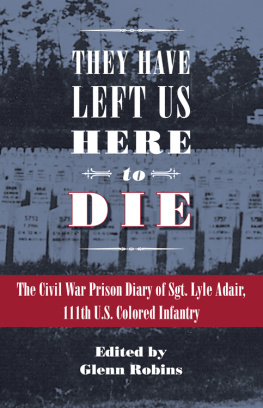Glenn Robins - They Have Left Us Here to Die
Here you can read online Glenn Robins - They Have Left Us Here to Die full text of the book (entire story) in english for free. Download pdf and epub, get meaning, cover and reviews about this ebook. year: 2013, publisher: Kent State University Press, genre: Politics. Description of the work, (preface) as well as reviews are available. Best literature library LitArk.com created for fans of good reading and offers a wide selection of genres:
Romance novel
Science fiction
Adventure
Detective
Science
History
Home and family
Prose
Art
Politics
Computer
Non-fiction
Religion
Business
Children
Humor
Choose a favorite category and find really read worthwhile books. Enjoy immersion in the world of imagination, feel the emotions of the characters or learn something new for yourself, make an fascinating discovery.

- Book:They Have Left Us Here to Die
- Author:
- Publisher:Kent State University Press
- Genre:
- Year:2013
- Rating:5 / 5
- Favourites:Add to favourites
- Your mark:
- 100
- 1
- 2
- 3
- 4
- 5
They Have Left Us Here to Die: summary, description and annotation
We offer to read an annotation, description, summary or preface (depends on what the author of the book "They Have Left Us Here to Die" wrote himself). If you haven't found the necessary information about the book — write in the comments, we will try to find it.
Glenn Robins: author's other books
Who wrote They Have Left Us Here to Die? Find out the surname, the name of the author of the book and a list of all author's works by series.
They Have Left Us Here to Die — read online for free the complete book (whole text) full work
Below is the text of the book, divided by pages. System saving the place of the last page read, allows you to conveniently read the book "They Have Left Us Here to Die" online for free, without having to search again every time where you left off. Put a bookmark, and you can go to the page where you finished reading at any time.
Font size:
Interval:
Bookmark:


Here to Die
of Sgt. Lyle Adair,
111th U.S. Colored
Infantry

ISBN 978-1-60635-101-7
Manufactured in the United States of America
Andersonville National Historic Site.
Adair, Lyle, b. 1843.
They have left us here to die : the Civil War prison diary of Sgt. Lyle Adair, 111th U.S.
Colored Infantry / [edited and annotated by] Glenn Robins.
p. cm. (Civil War in the North)
Includes bibliographical references and index.
ISBN 978-1-60635-101-7 (hardcover : alk. paper)
1. Adair, Lyle, b. 1843Diaries.
2. Prisoners of warConfederate States of AmericaDiaries.
3. Prisoners of warUnited StatesDiaries.
4. United StatesHistoryCivil War, 18611865Prisoners and prisons.
5. Military prisonsConfederate States of AmericaHistory.
6. Captivity narrativesConfederate States of America.
7. United StatesHistoryCivil War, 18611865Personal narratives.
8. United States. Army. Colored Infantry Regiment, 111th (18641866)
9. United StatesHistoryCivil War, 18611865Regimental histories.
I. Robins, Glenn.
II. Title.
E611.A33 2011
973.7'13dc23
2011016812
15 14 13 12 11 5 4 3 2 1


Font size:
Interval:
Bookmark:
Similar books «They Have Left Us Here to Die»
Look at similar books to They Have Left Us Here to Die. We have selected literature similar in name and meaning in the hope of providing readers with more options to find new, interesting, not yet read works.
Discussion, reviews of the book They Have Left Us Here to Die and just readers' own opinions. Leave your comments, write what you think about the work, its meaning or the main characters. Specify what exactly you liked and what you didn't like, and why you think so.









